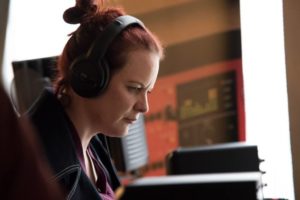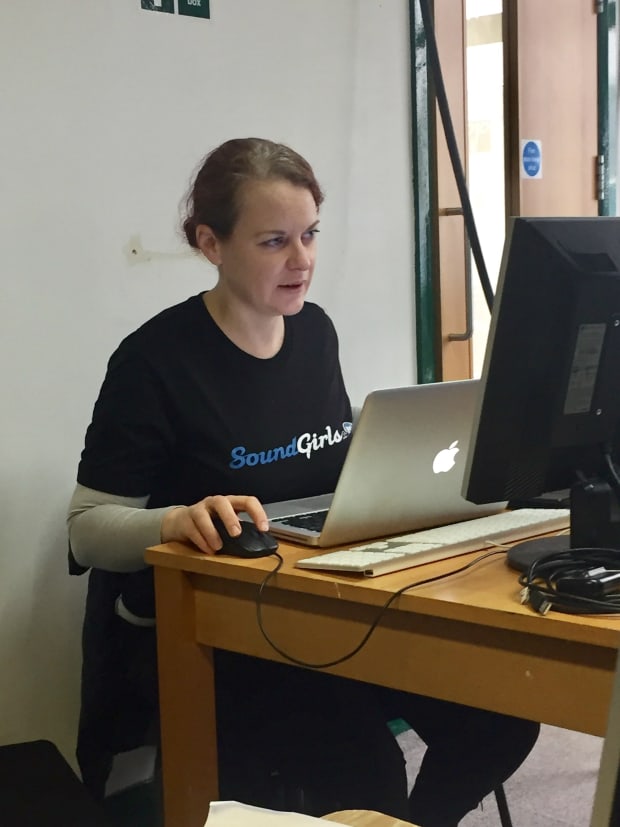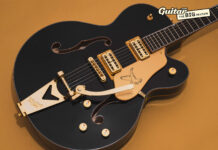
‘Creative licence is key’: Sound designer Kirsty Gillmore on producing theatre audio
Kirsty Gillmore’s devotion to all things audio has led her to carve out a career that focuses on creativity and exploration within the aural realm. After almost a decade at the BBC working in radio, Gillmore set up her own business specialising in theatre sound design, which, along with her voice acting work and desire to support the wider audio industry as part of equality organisation SoundGirls, has rendered her as someone who knows their way around both sides of the microphone.
To bring us back to the start of Gillmore’s varied career, we have to go back to a gig in New Zealand in the late 1990s. “I was listening to a band one night with a composer friend of mine and we started talking about the mix: how we couldn’t really hear the keyboards where they’d been placed; how the effects the guitarist were using were a bit odd. He said, Oh this is the sort of thing that a music producer does, have you ever thought about going into music production?” Not knowing any producers or engineers, Gillmore started to look around for a course in sound engineering – something that didn’t take long, as there were only two courses available in New Zealand at the time.
After graduating from the Music and Audio Institute of New Zealand in sound engineering, music and performance, Gillmore worked for a post-production company that she’d previously interned at. She’d occasionally do voiceover work here too, which is where her multi-hyphen job title began its early life.
At 24, Gillmore moved to London, feeling frustrated at the lack of opportunity in her native country. Spending eight years at the BBC in a number of different roles, including as a sound engineer involved in the digitisation of much of Radio 4’s archive and managing studios for BBC World Service, Gillmore left the corporation in 2010 to start her own business and focus on sound design – specifically in theatre.
The product of this was Sounds Wilde, a service offering character audioreel services for actors, who – for those not in the know – need a well-produced recording of their voice to get work performing on radio dramas and recording audiobooks. Gillmore helps actors capture their natural vocals (plus a selection of appropriate character voices) from her studio in north London, while also working as a voice actor herself.
Mic check
“It’s not what kit you use that’s important, it’s how you use it,” explains Gillmore, when PSNEurope asks her about her equipment of choice. “My favourite condenser microphone at the moment is an [AKG] C414 to record most people’s voices – it doesn’t colour the sound too much so it’s perfect for voice actors. While a warm tone is great, I have to err on the side of the microphone that’s not going to colour the sound too much to capture people’s different voices accurately. I like Audient interfaces which have a really clean sound, and use Focal monitors for my sound design work in post-production. I’m really fond of them because they give quite a detailed sound and it’s important for me – with the complex mixing I do for radio and short films – to be able to rely on my reference to know that what I hear is as accurate as possible.
“I’ve been a Pro Tools user for 20 years; it’s got its quirks, but I can’t imagine changing that now. I work from [digital audio workstation] Reaper a lot when I’m doing remote recordings, and use a lot of Waves plug ins, as I’m sure everybody does.”

Gillmore continues: “Having tools that accurately reflect sounds is useful to me, but I’m not completely reliant on my software to create the kind of sounds that I want. The tools are incredibly useful; software like Iris is great to manipulate sounds, but I rely quite a lot on really great bass sounds, especially for my sound design work. I’ve got an extensive sound library now, but if I can’t find the sounds I need, I create them.”
Creating new sounds to incorporate into a play’s audio tapestry is a “pretty cool” part of Gillmore’s work, and it’s something that requires a fair bit of research alongside lots of imagination and creative licence.
In 2017, Gillmore worked as the associate sound designer on award-winning play The Shape Of The Pain, which featured “exhilarating sound and lighting”, according to Guardian theatre critic Lyn Gardner. Gillmore was responsible for shaping the sound design through the four-week rehearsal process, which involved adjusting levels, editing cues, making decisions on placement (with both speakers and audio elements), and recording and implementing voiceovers and audio description elements. She also operated the sound for the production’s London previews.
Creative licence
Another recent project was a creative treasure trove for Gillmore, working on a ‘steampunk dystopian’ radio drama with a brief to design sounds for imagined Industrial Era machines that have never existed. How do you begin designing that?
“I had to do a lot of research into clockwork and machines of the time to figure out how they’d work,” she explains. “For the last episode we did, I had to invent sounds for a flying machine. The director sent me a drawing of the kind of thing he had in mind and said, I want it like to sound like a mosquito whine, but I also want it to sound very mechanical. So, I listened to the sounds of really early Wright Brothers-era flying machines, but then had to consider adding insect-like sounds, so incorporated the sound of a dragonfly fluttering for the plane’s wings.” To achieve this, Gillmore used recorded sound effects of an early aeroplane and mixed this with the resonating noise of a Tesla coil, a high-voltage electrical device invented in the 19th century.
“I enjoy projects where I’ve got a bit more creative licence, where I can work collaboratively with a director and I can suggest things to them. Sound design work can be quite isolating, and I prefer working in collaboration wherever possible. In theatre, especially, you might only meet the rest of the team once or twice. There’s a lot of making by yourself. In a lot of the projects I’ve worked on, people realise halfway through that they need someone to design the sound for it. This can result in what a former colleague of mine calls ‘dog bark, doorbell’ shows. All the director wants is a certain sound effect coming out of the right speaker, which is a kind of ‘sound design by numbers’.
“The best way I like to work is being brought onto a project early on and being able to talk about the creative vision collectively. Sometimes [in theatre], sound design can often be the last thought.”
Changing times
However, adds Gillmore, the public’s general attitude towards audio is changing. When Gillmore was first introduced to the world of sound through her composer friend at that gig in New Zealand, she didn’t know of anyone working in the business. Fast forward 15 years or so, and she’s “seeing people taking sound design more seriously.”
She elaborates: “I didn’t even know sound design was a thing in the New Zealand back in the late ’90s. Although, it is still a bit of a hidden art. I think you can see [perceptions of] sound in general at the Oscars, for example, where a lot of Academy voters simply abstained from voting in the sound editing and mixing categories, because they think they couldn’t possibly understand it. But they’d still almost always vote in the cinematography category because it’s visual – they can see it. I think the idea that sound is more of a mystery still exists.
“At the same time, I certainly think sound design has become more prominent within film. When I talk to people about sound, they tell me they really enjoyed the sound in films like Interstellar or Baby Driver, a film where the sound concept was a decision they made really early on in the process.”
The rise of voice-based technology in products like Apple’s Siri and Amazon Echo’s Alexa command services means people are opening themselves up to audio media more than ever before. Now, people are experiencing as much audio media as they are visual media, says Gillmore, with “audiobooks on the rise; there’s talk of podcasting overtaking radio – which is itself experiencing another golden age.” This is all great news for voice actors – like Gillmore – as the demand for audio-based drama increases.
Along with her voice acting work, Gillmore is the European director for SoundGirls, an organisation that aims to support women working in all sectors of sound. She regularly writes blog posts for its website and organises monthly events in London to get women in the business networking and linking up. She says: “The rise in social media has meant it’s now easier than ever for women to connect in the industry – to find their networks and become more visible in the industry, because we have platforms to do so.”
SoundGirls is free to join and open to all genders; “as long as [supporting women in audio] is something you’re an advocate for. We don’t close it off to anyone.”
You can’t help but think that Gillmore has taken a similar approach to her career – by staying open-minded, following her curiosity and pursuing a more creative path in audio, she’s resisted putting herself in a box. Cue door opening sound effect.
www.soundgirls.org
Source: mi-pro.co.uk




